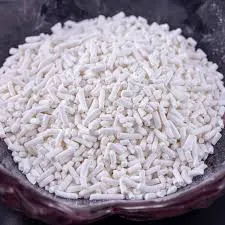
sodium metabisulfite preservative
The Role of Sodium Metabisulfite as a Preservative
Sodium metabisulfite, a white crystalline powder with the chemical formula Na₂S₂O₅, is a widely used food preservative known for its antioxidant and antimicrobial properties. It plays a crucial role in extending the shelf life of various food products, ensuring safety and quality. This article delves into the applications, benefits, and safety concerns surrounding sodium metabisulfite in the food industry.
Applications in Food Preservation
Sodium metabisulfite is primarily used in the food industry to inhibit the growth of pathogenic and spoilage microorganisms. Its effectiveness in preserving a wide range of food products has made it a popular choice among food manufacturers. Common applications include
1. Dried Fruits Sodium metabisulfite is extensively used in the preservation of dried fruits, such as apricots and raisins. By preventing oxidative browning reactions, it helps maintain the vibrant color and extends the shelf life of these products.
2. Wine and Beer Production In winemaking, sodium metabisulfite serves as a crucial additive. It acts as a sterilizing agent, preventing the growth of unwanted bacteria and wild yeasts. It also helps preserve the wine’s flavor and aroma by limiting oxidation.
3. Vegetables and Potatoes The preservative is used to blanch vegetables and prevent discoloration in peeled potatoes. This helps maintain the quality and appearance, ensuring a more appealing product for consumers.
Benefits of Sodium Metabisulfite
sodium metabisulfite preservative

The benefits of using sodium metabisulfite as a preservative are multifaceted. Firstly, its ability to inhibit oxidation helps maintain the quality and nutritional content of food. Oxidation can lead to flavor loss and the degradation of essential nutrients, which sodium metabisulfite effectively combats.
Additionally, the compound is relatively inexpensive and easy to incorporate into existing food production processes. Its effectiveness at low concentrations makes it an economically viable solution for manufacturers aiming to enhance product longevity without significantly affecting the end product's taste or safety.
Sodium metabisulfite is also valuable in preventing spoilage due to microorganisms, thus reducing food waste. By extending shelf life, it allows for better inventory management and distribution, ultimately benefiting retailers and consumers alike.
Safety Concerns and Regulations
Despite its benefits, the use of sodium metabisulfite is not without controversy. Some individuals may experience allergic reactions to sulfites, which can manifest as headaches, asthma attacks, or other respiratory issues. As a result, regulatory agencies in several countries require that foods containing sodium metabisulfite be clearly labeled.
The U.S. Food and Drug Administration (FDA) has designated sodium metabisulfite as Generally Recognized as Safe (GRAS), although certain limits on its usage exist. The European Union (EU) also regulates its use, allowing it in specific food categories but requiring labeling when concentrations exceed a certain threshold.
Manufacturers must be diligent in monitoring and adhering to safety guidelines to protect consumers who might be sensitive to sodium metabisulfite.
Conclusion
Sodium metabisulfite is a versatile and effective preservative widely used in the food industry. Its ability to inhibit oxidation and microbial growth makes it invaluable for maintaining the quality and safety of various food products. While concerns regarding allergies and sensitivities necessitate careful regulation and labeling, its overall benefits contribute significantly to extending shelf life and minimizing food waste. As the food industry continues to evolve, sodium metabisulfite remains a relevant and essential component in contemporary food preservation strategies.
-
The Safety Challenges of Ammonium Nitrate FertilizerNewsJun.26,2025
-
The Critical Role of Mining ChemicalsNewsJun.26,2025
-
Shelf Life of Glacial Acetic Acid Food GradeNewsJun.26,2025
-
Enhancing PVC Longevity with 1,2,3-Benzotriazole InnovationsNewsJun.26,2025
-
China’s Dominance in Food Additive ProductionNewsJun.26,2025
-
Can Aluminum Hydroxide Replace More Toxic Alternatives?NewsJun.26,2025
-
PE and PP Plastics with Benzotriazole AdditivesNewsJun.12,2025
Hebei Tenger Chemical Technology Co., Ltd. focuses on the chemical industry and is committed to the export service of chemical raw materials.
-

view more DiethanolisopropanolamineIn the ever-growing field of chemical solutions, diethanolisopropanolamine (DEIPA) stands out as a versatile and important compound. Due to its unique chemical structure and properties, DEIPA is of interest to various industries including construction, personal care, and agriculture. -

view more TriisopropanolamineTriisopropanolamine (TIPA) alkanol amine substance, is a kind of alcohol amine compound with amino and alcohol hydroxyl, and because of its molecules contains both amino and hydroxyl. -

view more Tetramethyl Thiuram DisulfideTetramethyl thiuram disulfide, also known as TMTD, is a white to light-yellow powder with a distinct sulfur-like odor. It is soluble in organic solvents such as benzene, acetone, and ethyl acetate, making it highly versatile for use in different formulations. TMTD is known for its excellent vulcanization acceleration properties, which makes it a key ingredient in the production of rubber products. Additionally, it acts as an effective fungicide and bactericide, making it valuable in agricultural applications. Its high purity and stability ensure consistent performance, making it a preferred choice for manufacturers across various industries.











